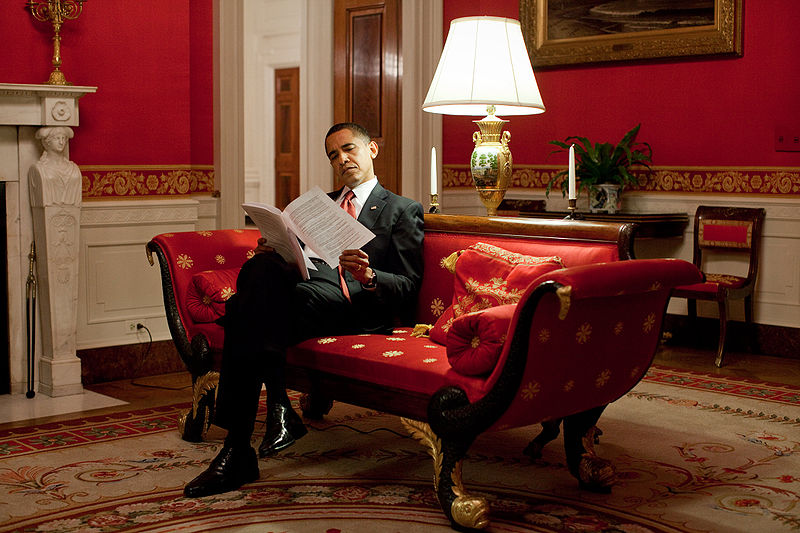Red Room: From Kennedy to Obama

Carpet Name
- Aubusson (French)
- The current carpet is a reproduction of the original Aubusson from 1815
Red Room History
The Red Room received its name in the 1840s from its vivid color scheme, made all the more striking by its small size. While many First Families have enjoyed the room, two First Ladies in particular made special use of it. Beginning in 1809, First Lady Dolley Madison held Wednesday Drawing Rooms that opened the doors for socializing between members of opposite political parties during a period of fierce partisan segregation. Her success as the Capital’s hostess redefined the role of the First Lady and helped usher in pivotal discussions in the run-up to the War of 1812. Very shortly after her husband's inauguration in 1933, First Lady Eleanor Roosevelt hosted the first of many press conferences for female reporters in the Red Room. Because female reporters were excluded from the president's press conferences, Mrs. Roosevelt's press conferences erased a social barrier. Though originally Mrs. Roosevelt discussed cooking and housekeeping topics, as her involvement in social issues and her rate of travel increased, the subject matter at these press conferences turned to discussions of domestic policies.
During the Kennedy restoration in the 1960s, a French Aubusson rug (circa 1815) in shades of red, cream and sage from the White House collection was acquired for the room and was copied in 1965 to prevent wear. It features a center medallion of red anthemion with borders of laurel leaf, roses, and medallions similar to the patterns found in the room's upholstery and decorative tapes.
A Brief History of Aubusson Carpets
Aubusson carpets are fine carpets woven in France dating from the 15th to 19th centuries. Aubussons were crafted with the assistance of architects and artists of the French royal court. They were originally made in France as a pileless carpet with a floral medallion in pastel colors.
Today's Aubusson's are woven in India and China and have been adapted by the addition of a pile. The Aubusson area was best known as an important tapestry-weaving center until, in an attempt to meet the great demand for knotted carpets, the King's Council set up a carpet-weaving enterprise there in the early 1740s. Initially the carpets were copies of imported Turkish designs. Louis XV and Madame de Pompadour were among the first clients, placing orders through agents in Paris. Sadly, the demand for oriental rugs did not last and the artist Pierre-Jose Perrot, who had already been involved with designing Savonnerie carpets, was called upon to design carpets in the French style in 1750.
Another painter, Le Lorrain, produced a radical new design, "a grande mosaic", which was a sophisticated precursor to the 19th century floral carpets. A central medallion of flowers is surrounded by dainty rosettes, flowers and garlands. Aubusson carpets were originally made as both knotted-pile carpets and later in the 18th century as flat woven slit-tapestry technique carpets produced in the same way as their tapestries. The Aubussons that are popular and readily available today are typically flat weaves.
The Aubusson floral tradition was never completely abandoned, although the trend began to lean towards the neo-classical Empire style created by two architects (Percier and Fontaine) after the Proclamation of the French Empire in 1804. That gave rise to elegant Savonnerie and Aubusson carpets whose patterns are influenced by antique classical trophies or Etruscan and Roman motifs. These tend to be in a dark rich palette, sometimes in different shades of the same colour, resulting in a multi dimensional look.
Nineteenth-century Aubusson tapestry-woven carpets, which were produced in great quantities, are popular today with interior decorators in Europe and North America. Trailing ribbons, bows and blowsy roses woven in soft pastel shades- of rose, dovey greys, cafe-au-lait and pale yellows conjure a very feminine look well suited for sitting rooms and bedrooms. Seventeenth and eighteenth-century Aubusson carpets in good condition are finds. As such an Aubusson in good condition garners a high price. To learn more about French rugs and their history, visit our French Rugs section.
Sources and inspiration: Bérinstain, Valérie, et al. L'art du tapis dans le monde (The art of carpets in the world). Paris: Mengès, 1996. Print.; Jerrehian Jr., Aram K.A. Oriental Rug Primer. Philadelphia: Running Press, 1980. Print.; Herbert, Janice Summers. Oriental Rugs, New York: Macmillan, 1982. Print.; Hackmack, Adolf. Chinese Carpets and Rugs, Rutland and Tokyo: Tuttle, 1980. Print. ; De Moubray, Amicia, and David Black. Carpets for the home, London: Laurence King Publishing, 1999. Print.; Jacobsen, Charles. Oriental Rugs A Complete Guide, Rutland and Tokyo: Tuttle, 1962. Print.; Bashir, S. (n.d.). Personal interview.; Web site sources and dates of consultation vary (to be confirmed). Without prejudice to official usage.
Place an Order
We can reproduce any carpet shown on this page in the size and colors of your choice. For more information or to place an order, call us at +1-514-735-1958 from Monday to Saturday between 10 am and 5 pm Eastern standard time or feel free to e-mail us at [email protected]


 Tapis d'Orient Bashir | Bashir Persian Rugs
Tapis d'Orient Bashir | Bashir Persian Rugs
 @tapisbashir
@tapisbashir
 @bashircarpets
@bashircarpets
 @bashircarpets
@bashircarpets